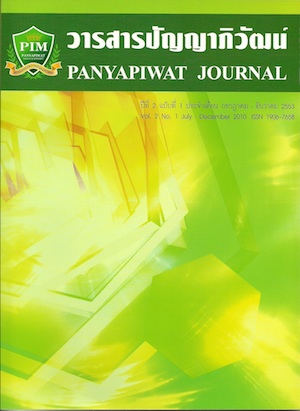นักท่องเที่ยวสูงอายุ: กลุ่มเป้าหมายที่มีศักยภาพสำหรับธุรกิจการท่องเที่ยว
Main Article Content
Abstract
บทคัดย่อ
ผู้สูงอายุเป็นกลุ่มเป้าหมายที่ธุรกิจการท่องเที่ยวไทยไม่ควรมองข้าม โดยเฉพาะในสภาวะเศรษฐกิจปัจจุบัน ผู้สูงอายุจำนวนหนึ่งเป็นกลุ่มนักท่องเที่ยวที่น่าจะให้ความสำคัญ เพราะมีกำลังซื้อ ไม่มีข้อจำกัดด้านเวลาในการเดินทาง และยังมีจำนวนเพิ่มมากขึ้นอย่างต่อเนื่องในแต่ละปี ผู้ประกอบการธุรกิจท่องเที่ยวจึงควรตระหนักถึงช่องทางการเพิ่มโอกาสทางการตลาดของตนจากกลุ่มคนเหล่านี้ แต่การจะทำธุรกิจการท่องเที่ยวให้ประสบความสำเร็จได้นั้น จำเป็นต้องมีข้อมูลรอบด้านเพื่อช่วยในการตัดสินใจ บทความนี้จึงขอนำเสนอข้อมูลทั่วไปและผลงานวิจัยทั้งในประเทศและต่างประเทศที่ผู้ประกอบธุรกิจการท่องเที่ยวควรทราบเกี่ยวกับนักท่องเที่ยวสูงอายุ เพื่อจะได้สามารถวางแผนการดำเนินงานและจัดบริการทางการท่องเที่ยวที่เหมาะสม และดึงดูดให้ผู้สูงอายุตัดสินใจเดินทางท่องเที่ยว
คำสำคัญ : นักท่องเที่ยว, ผู้สูงอายุ, การตลาดการท่องเที่ยว
Abstract
Given the current economic situation, the senior population is a market that the tourism industry should not overlook. A certain proportion of the elderly has high buying power and usually has no constraint on when they travel; hence they have high potential as tourists. Moreover, the number is steadily rising every year. Tourism entrepreneurs should be aware of the opportunity for market expansion from this emerging segment. To be successful in tourism business, tour operators and agencies need all pertinent information before making decisions. This paper reveals general information as well as Thai and international research studies regarding senior tourists so that tour operators and agencies can plan and organize suitable tourism activities to coax senior people to travel.
Keywords : Tourists, Senior Citizen, Tourism Marketing
Article Details
I and co-author(s) certify that articles of this proposal had not yet been published and is not in the process of publication in journals or other published sources. I and co-author accept the rules of the manuscript consideration. Both agree that the editors have the right to consider and make recommendations to the appropriate source. With this rights offering articles that have been published to Panyapiwat Institute of Management. If there is a claim of copyright infringement on the part of the text or graphics that appear in the article. I and co-author(s) agree on sole responsibility.
References
กิจกรรมส่งเสริมสุขภาพและเครือข่ายผู้สูงอายุ. (2553). บทบาทผู้สูงอายุต่อสังคมครอบครัวชุมชน. สืบค้นเมื่อ 23 กรกฎาคม 2553, จาก http://hp.anamai.moph.go.th/soongwai/statics/about/soongwai/topic006.php
สถาบันวิจัยระบบสาธารณสุข. (2552).ท่องเที่ยวแนวใหม่ที่ปราศจากอุปสรรคสําหรับคนทั้งมวล. สืบค้นเมื่อ 23 กรกฎาคม 2553, จาก http://www.hsri.or.th/th/whatnews/detail.php?id=181&key=activity
สภาอุตสาหกรรมท่องเที่ยวแห่งประเทศไทย. (2553). ประเมินผลกระทบอุตสาหกรรมท่องเที่ยวของไทยจากเหตุการณ์ความขัดแย้งทางการเมือง. สืบค้นเมื่อ 20 กรกฎาคม 2553, จาก http://www.thailandtourismcouncil.org/home.php
สํานักงานกองทุนสนับสนุนการวิจัย. (2553). มาตรฐานขั้นตํ่าสําหรับที่พักอาศัยและสภาพแวดล้อมของผู้สูงอายุ.สืบค้นเมื่อ 23 กรกฎาคม 2553, จากhttp://www.trf.or.th/research/abstract/Thai/RDG4730011.tx
สํานักงานสถิติแห่งชาติ. (2550). รายงานการสํารวจประชากรสูงอายุในประเทศไทยพ.ศ. 2550. สืบค้นเมื่อ 10 กรกฎาคม 2553, จาก http://service.nso.go.th/nso/nsopublish/pocketBook/older-pb50.pdf
สุขภาวะผู้สูงอายุ. (2546). ภาพรวมของสิทธิผู้สูงอายุตามพระราชบัญญัติผู้สูงอายุพ.ศ. 2546. สืบค้นเมื่อ 23 กรกฎาคม 2553, จาก http://www.stou.ac.th/stoukc/elder/main2_14.html
อัญชลี พิชญางกูร. (2550). รายงานการวิจัยของบริษัทโอกิลวี่แอนด์เมเธอร์ประเทศไทย. อ้างถึงใน Sasinand. (2550). ประเทศไทยได้กลายเป็นสังคมผู้สูงอายุไปเสียแล้ว. สืบค้นเมื่อ 20 กรกฎาคม2553, จาก http://gotoknow.org/blog/goodliving/133071?page=3
Ananth, M., DeMicco, F. J., Moreo, P. J., & Howey, R. M. (1992). Marketplace lodging needs of mature travelers. [doi: DOI: 10.1016/0010-8804(92)90005-P]. The Cornell Hotel and Restaurant Administration Quarterly, 33(4), 12-24.
Anderson, B., & Langmeyer, L. (1982). The under-50 and over-50 traveler: A profile of similarities and differences. Journal of Travel Research, 20(4), 20-24.
Backman, K., Backman, S., & Silverberg, K. (1999). Investigation into the psychographics of senior nature-based travelers. Tourism Recreation Research, 24(1), 13-22.
Bai, B., Jang, S. S., Cai, L. A., & O’leary, J. T. (2001). Determinants of travel mode choice of senior travelers to the United States. Journal of Hospitality & Leisure Marketing, 8(3), 147-168.
Batra, A. (2009). Senior Pleasure Tourists: Examination of Their Demography, Travel Experience, and Travel Behavior Upon Visiting the Bangkok Metropolis. International Journal of Hospitality & Tourism Administration, 10(3), 197-212.
Blazey, M. A. (1987). The differences between participants and non-participants in a senior travel program. Journal of Travel Research, 26(1), 7-12.
Dardis, R., Soberon-Ferrer, H., & Patro, D. (1994). Analysis of leisure expenditures in the United States. Journal of Leisure Research, 26(4), 309-321.Fleischer, A., & Pizam, A. (2002). Tourism constraints among Israeli seniors. [doi: DOI: 10.1016/S0160-7383(01)00026-3]. Annals of Tourism Research, 29(1), 106-123.
Hong, G.-S., Kim, S. Y., & Lee, J. (1999). Travel expenditure patterns of elderly households in the US. Tourism Recreation Research, 24(1), 43-52.
Hong, G.-S., Morrison, A. M., & Cai, L. A. (1996). Household Expenditure Patterns for Tourism Products and Services. Journal of Travel & Tourism Marketing, 4(4), 15-40.
Hsu, C. H. C. (2001). Importance and Dimen-sionality of Senior Motorcoach Traveler Choice Attributes. Journal of Hospitality & Leisure Marketing, 8(3), 51-70.
Jang, S., & Wu, C.-M. E. (2006). Seniors’ travel motivation and the influential factors: An examination of Taiwanese seniors. [doi: DOI: 10.1016/j.tourman.2004.11.006]. Tourism Management, 27(2), 306-316.
Javalgi, R. G., Thomas, E. G., & Rao, S. R. (1992). Consumer behavior in the U.S. pleasure travel marketplace: An analysis of senior and nonsenior travelers. Journal of Travel Research, 31(2), 14-19.
Lee, S. H., & Tideswell, C. (2005). Understanding attitudes towards leisure travel and the constraints faced by senior Koreans. Journal of Vacation Marketing, 11(3), 249-264.
Lieux, E. M., Weaver, P. A., & McCleary, K. W. (1994). Lodging preferences of the senior tourism market. [doi: DOI: 10.1016/0160-7383(94)90079-5]. Annals of Tourism Research, 21(4), 712-728.
McGuire, F. A. (1984). A factor analytic study of leisure constraints in advanced adulthood. Leisure Sciences: An Interdisciplinary Journal, 6(3), 313-326.Nimrod, G. (2008). Retirement and tourism Themes in retirees’ narratives. [doi: DOI: 10.1016/j.annals.2008.06.001]. Annals of Tourism Research, 35(4), 859-878.
Romsa, G., & Blenman, M. (1989). Vacation patterns of the elderly German. [doi: DOI: 10.1016/0160-7383(89)90066-2]. Annals of Tourism Research, 16(2), 178-188.
Shoemaker, S. (1989). Segmentation Of The Senior Pleasure Travel Market. Journal of Travel Research, 27(3), 14-21.
Tongren, H. N. (1980). Travel Plans of the Over-65 Market Pre and Postretirement. Journal of Travel Research, 19(2), 7-11.
Westbrook, R. A. (1987). Product/consumption-based affective responses and postpurchase processes. Journal of Marketing Research, 24, 258-270.
Zimmer, Z., Brayley, R., & Searle, M. (1995). Whether to go and where to go: Identification of important influences on seniors’ decisions to travel. Journal of Travel Research, 33(3), 3-10.


